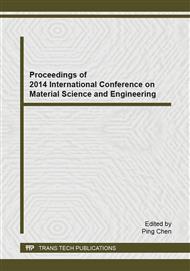[1]
A. S. Milani, W. Dabboussi, et al., An improved multi-objective identification of Johnson–Cook material parameters. Int.J. Imp. Eng. 36 (2009) 294-302.
DOI: 10.1016/j.ijimpeng.2008.02.003
Google Scholar
[2]
Q.Y. Hou, J.T. Wang. A modified Johnson–Cook constitutive model for Mg–Gd–Y alloy extended to a wide range of temperatures. Comput. Mater. Sci. 50(2010)147-152.
DOI: 10.1016/j.commatsci.2010.07.018
Google Scholar
[3]
A. Shrot, M. Baker. Determination of Johnson–Cook parameters from machining simulations. Comput. Mater. Sci. (2011), doi: 10. 1016/j. commatsci. 2011. 07. 035.
Google Scholar
[4]
D. Umbrello, R. M'Saoubi, J,C. Outeiro. The influence of Johnson–Cook material constants on finite element simulation of machining of AISI 316L steelInt.J. Machi. Tool & Manu. 47(2007)462-470.
DOI: 10.1016/j.ijmachtools.2006.06.006
Google Scholar
[5]
Y. Wang, Y.X. Zhou Y.M. Xia. A constitutive description of tensile behavior for brass over a wide range of strain rates. Mater. Sci. Eng. A 372(2004)186-190.
DOI: 10.1016/j.msea.2003.12.009
Google Scholar
[6]
X.B. Wang. Effects of constitutive parameters on adiabatic shear localization for ductile metal based on JOHNSON-COOK and gradient plasticity models. Trans. Nonferrous. Met. Soc. China. 16(2006)1362-1369.
DOI: 10.1016/s1003-6326(07)60021-1
Google Scholar
[7]
M. Franulovic,R. Basan, I. Prebil. Genetic algorithm in material model parameters' identification for low-cycle fatigue. Comput. Mater. Sci. 50 (2009)505-510.
DOI: 10.1016/j.commatsci.2008.11.012
Google Scholar
[8]
X.T. Feng, C.X. Yang. Genetic evolution of nonlinear material constitutive models. Comput. Mehods. Appl. Mech. Engrg. 190 (2001)5957-5973.
Google Scholar
[9]
C.F. Castro C.A.C. Antonio L.C. Sousa. Optimisation of shape and process parameters in metal forging using genetic algorithms. J. Mater. Pro. Technol. 146(2004)356-364.
DOI: 10.1016/j.jmatprotec.2003.11.027
Google Scholar
[10]
J. Luo M.Q. Li, et al., Constitutive model for high temperature deformation of titanium alloys using internal state variables. Mech. Mater. 42(2010)157-165.
DOI: 10.1016/j.mechmat.2009.10.004
Google Scholar
[11]
J. Périaux, G. Winter. Genetic Algorithms in Engineering and Computer Science. John Wiley and Sons. (1995).
Google Scholar
[12]
R.L. Haupt, S.E. Haupt. Practical Genetic Algorithms. John Wiley and Sons. (1998).
Google Scholar


